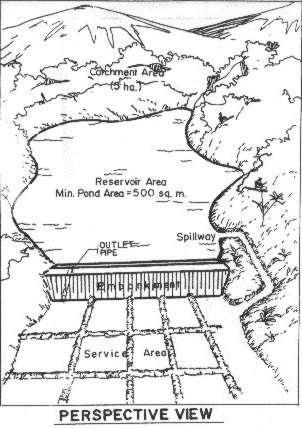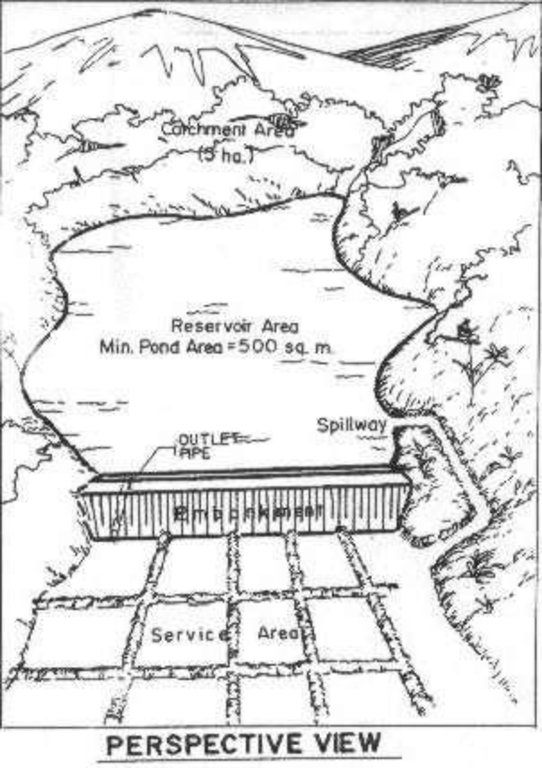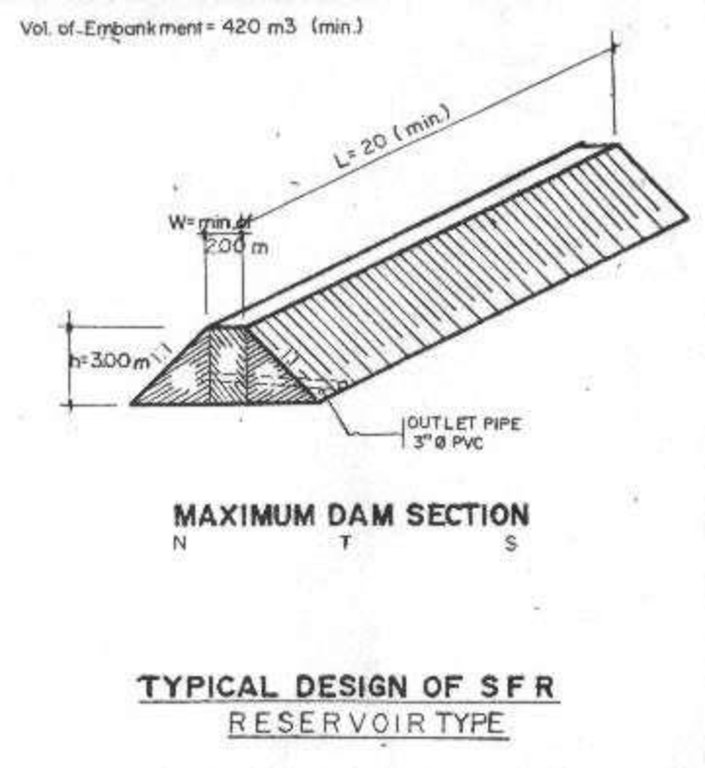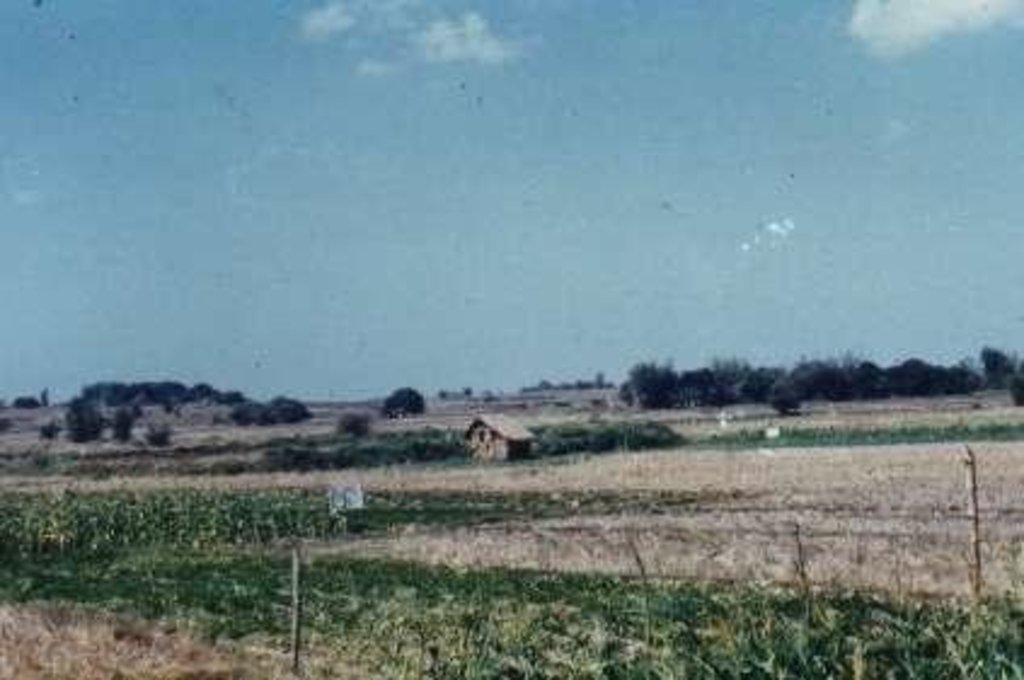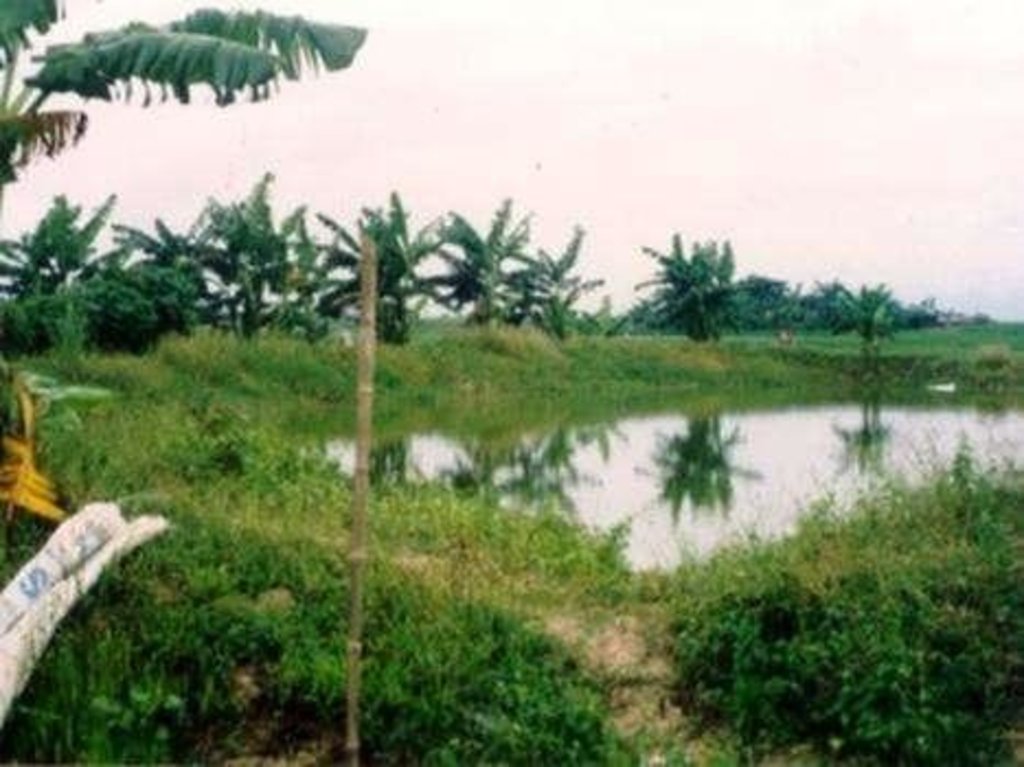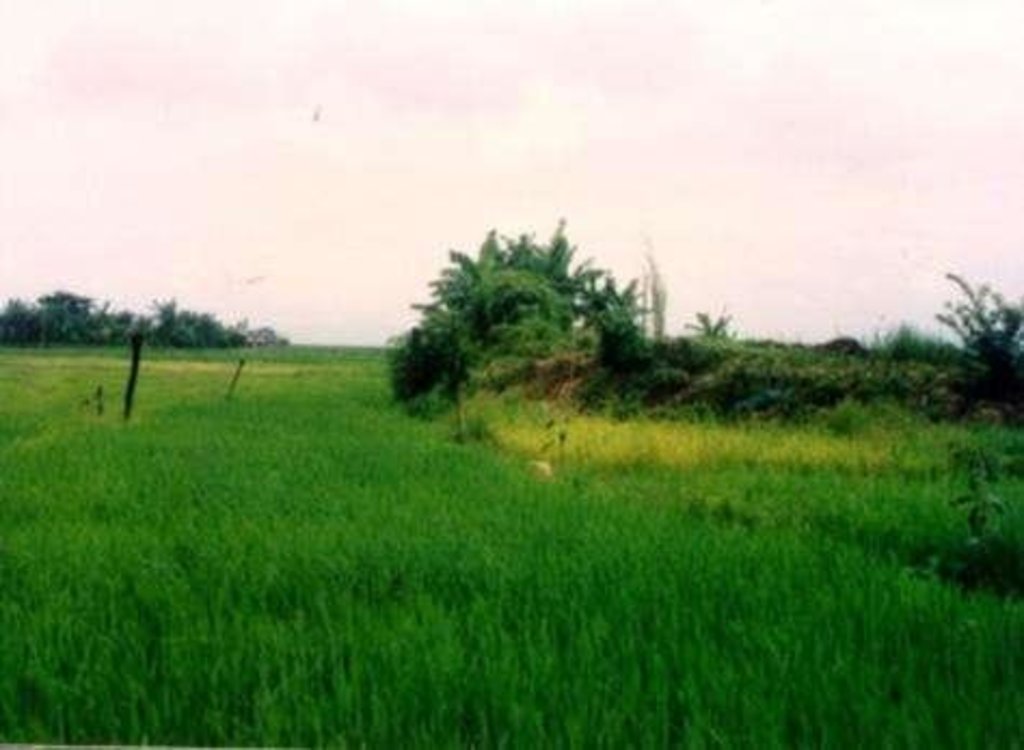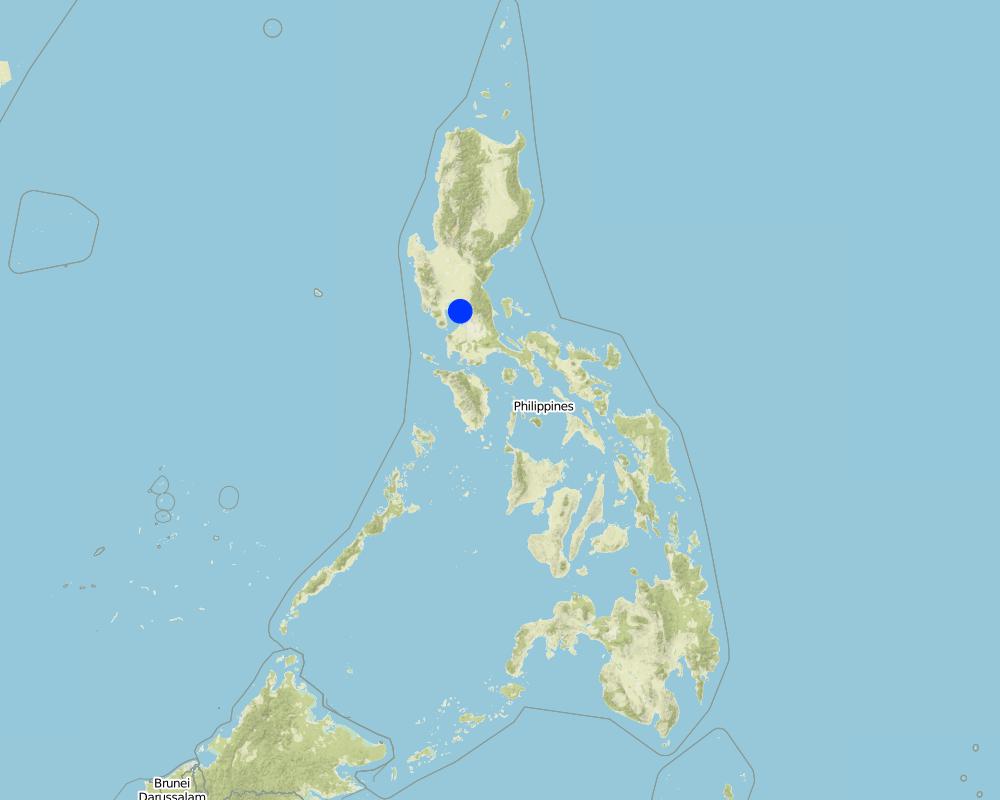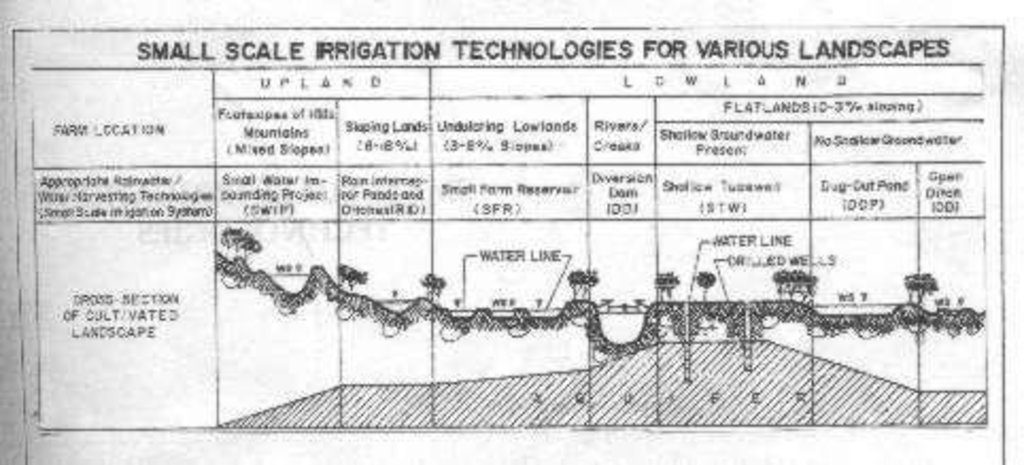Small Farm Reservoir (SFR) [ប្រទេសហ្វីលីពីន]
- ការបង្កើត៖
- បច្ចុប្បន្នភាព
- អ្នកចងក្រង៖ Philippine Overview of Conservation Approaches and Technologies
- អ្នកកែសម្រួល៖ –
- អ្នកត្រួតពិនិត្យច្រើនទៀត៖ Deborah Niggli, Alexandra Gavilano
Tabon
technologies_1102 - ប្រទេសហ្វីលីពីន
ពិនិត្យមើលគ្រប់ផ្នែក
ពង្រីកមើលទាំងអស់ បង្រួមទាំងអស់1. ព័ត៌មានទូទៅ
1.2 ព័ត៌មានលម្អិតពីបុគ្គលសំខាន់ៗ និងស្ថាប័នដែលចូលរួមក្នុងការវាយតម្លៃ និងចងក្រងឯកសារនៃបច្ចេកទេស
អ្នកជំនាញឯកទេស SLM:
SANDOVAL TERESITA
Bureau of Soils and Water Management
ប្រទេសហ្វីលីពីន
អ្នកជំនាញឯកទេស SLM:
GICANA DOLORES MAE
Bureau of Soils and Water Management
ប្រទេសហ្វីលីពីន
1.3 លក្ខខណ្ឌទាក់ទងទៅនឹងការប្រើប្រាស់ទិន្នន័យដែលបានចងក្រងតាមរយៈ វ៉ូខេត
អ្នកចងក្រង និង(បុគ្គលសំខាន់ៗ)យល់ព្រមទទួលយកនូវលក្ខខណ្ឌនានាទាក់ទងទៅនឹងការប្រើប្រាស់ទិន្នន័យដែលបានចងក្រងតាមរយៈវ៉ូខេត:
បាទ/ចា៎
1.4 សេចក្តីប្រកាសស្តីពីចីរភាពនៃការពណ៌នាពីបច្ចេកទេស
តើបច្ចេកទេសដែលបានពណ៌នានេះមានបញ្ហាដែលផ្តោតលើការធ្លាក់ចុះគុណភាពដី, បើដូច្នេះវាមិនអាចត្រូវបានប្រកាសថាជាបច្ចេកទេសនៃការគ្រប់គ្រងប្រកបដោយចីរភាពទេ?
ទេ
2. ការពណ៌នាពីបច្ចេកទេស SLM
2.1 ការពណ៌នាដោយសង្ខេបពីបច្ចេកទេស
និយមន័យបច្ចេកទេស:
The Small Farm Rerservoir is an earth dam structure used to trap harvest and store rainfall and water runoff.
2.2 ការពណ៌នាលម្អិតពីបច្ចេកទេស
ការពណ៌នា:
The small farm reservoir (SFR) is a small water impounding earth dam structure to collect rainfall and runoff, designed for use in a single farm, and typically has an area of about 300-2,000 square meters. The embankment height above ground level is less than 4 meters. It can be easily constructed with a bulldozer or manual labor. Irrigation is done with PVC siphon pipes or pumps. SFR is used in rainfed-growing areas to provide supplemental irrigation to a wet season crop and partial irrigation to a dry season crop. Aside from irrigation and aquaculture, water in the reservoir could also be used for small scale livestock watering, wallowing areas for animals, e.g. ducks and picnic ground.
2.3 រូបភាពនៃបច្ចេកទេស
2.5 ប្រទេស/តំបន់/ទីតាំងកន្លែង ដែលបច្ចេកទេសត្រូវបានអនុវត្ត និងបានគ្រប់ដណ្តប់ដោយការវាយតម្លៃនេះ
ប្រទេស:
ប្រទេសហ្វីលីពីន
បញ្ជាក់បន្ថែមពីលក្ខណៈនៃទីតាំង:
Pangasinan, Nueva Ecija, Tarlac, Isabela, Bulacan, Ilocos Norte
បញ្ជាក់ពីការសាយភាយនៃបច្ចេកទេស:
- ត្រូវបានផ្សព្វផ្សាយត្រឹមតំបន់មួយ
ប្រសិនបើមិនច្បាស់ពីទំហំផ្ទៃដី សូមធ្វើការប៉ាន់ប្រម៉ាណ:
- 100-1,000 គម2
មតិយោបល់:
Total area covered by the SLM Technology is 8884 m2.
The Department of Agriculture (DA) thru the Bureau of Soils and Water Management (BSWM) and different DA-Regional Field Units has embarked on intensive and fast-track implementation of the technology to conserve rain water during wet season to prevent flooding and to provide supplemental irrigation during dry season.
Map
×2.6 កាលបរិច្ឆេទនៃការអនុវត្ត
ប្រសិនបើមិនច្បាស់ឆ្នាំ សូមបញ្ជាក់កាលបរិច្ឆេទដែលប្រហាក់ប្រហែល:
- តិចជាង 10ឆ្នាំមុន (ថ្មី)
2.7 ការណែនាំពីបច្ចេកទេស
សូមបញ្ជាក់តើបច្ចេកទេសត្រូវបានណែនាំឱ្យអនុវត្តដោយរបៀបណា:
- តាមរយៈគម្រោង / អន្តរាគមន៍ពីខាងក្រៅ
មតិយោបល់ (ប្រភេទនៃគម្រោង ។ល។):
From other areas with similar (areas where runoff can be collected and impounded and used for supplementary irrigation).
3. ចំណាត់ថ្នាក់នៃបច្ចេកទេស SLM
3.1 គោលបំណងចម្បង (១ ឬច្រើន) នៃបច្ចេកទេសនេះ
- ធ្វើឱ្យប្រសើរឡើងនូវផលិតកម្ម
- កាត់បន្ថយ, បង្ការ, ស្តារឡើងវិញនូវការធ្លាក់ចុះគុណភាពដី
3.2 ប្រភេទដីប្រើប្រាស់មួយប្រភេទ (ច្រើនប្រភេទ) ដែលបានអនុវត្តបច្ចេកទេស

ដីដាំដំណាំ
- ដំណាំប្រចាំឆ្នាំ
ចំនួនសារដែលដាំដំណាំក្នុងមួយឆ្នាំ:
- 2
សូមបញ្ជាក់:
Longest growing period in days: 180, Longest growing period from month to month: May - Oct; Second longest growing period in days: 120, Second longest growing period from month to month: Nov - Feb
មតិយោបល់:
Major land use problems (compiler’s opinion): Very low yield of any crop due to inadequate moisture to sustain crop growth.
Major land use problems (land users’ perception): Unpredictable weather condition or occurrence of extreme climatic condition (La Nina or El Nino) constrained yield improvement.
3.5 ក្រុម SLM ដែលបច្ចេកទេសស្ថិតនៅក្នុង
- ការស្តុកទុកទឹក
- ការគ្រប់គ្រងប្រព័ន្ធស្រោចស្រព (រួមទាំងការផ្គត់ផ្គង់ទឹក ប្រព័ន្ធបង្ហូរ)
- ការបែងចែកទឹក និងប្រព័ន្ធបង្ហូរ
3.6 វិធានការ SLM ដែលបញ្ចូលនូវបច្ចេកទេស

វិធានការក្សេត្រសាស្ត្រ
- A3: ការរក្សាស្រទាប់ដីខាងលើ
- A5: ការគ្រប់គ្រងគ្រាប់ពូជ បង្កើនប្រភេទពូជ
A3: ប្រព័ន្ធភ្ជួររាស់ខុសៗគ្នា:
A 3.2: Reduced tillage (> 30% soil cover)

វិធានការរចនាស័ម្ពន្ធ
- S1: ការធ្វើដីថ្នាក់ៗតាមជម្រាលភ្នំ
មតិយោបល់:
Type of agronomic measures: mixed cropping / intercropping, legume inter-planting, rotations / fallows, minimum tillage
3.8 ការពារ កាត់បន្ថយ ឬស្តារឡើងវិញនៃការធ្លាក់ចុះគុណភាពដី
បញ្ជាក់ពីគោលដៅរបស់បច្ចេកទេស ដែលផ្តោតទៅការធ្លាក់ចុះគុណភាពដី:
- ការការពារការធ្លាក់ចុះគុណភាពដី
- ការជួសជុល/ ស្តារឡើងវិញនៃឱនភាពដីធ្ងន់ធ្ងរ
4. បច្ចេកទេសជាក់លាក់ សកម្មភាពអនុវត្ត ធាតុចូល និងថ្លៃដើម
4.1 គំនូសបច្ចេកទេសនៃបច្ចេកទេសនេះ
លក្ខណៈពិសេសនៃបច្ចេកទេស (ទាក់ទងនឺងគំនូរបច្ចេកទេស):
Uses of Small Farm Reservoir (SFR) system
Technical knowledge required for field staff / advisors: moderate
Technical knowledge required for land users: moderate
Main technical functions: control of dispersed runoff: retain / trap, control of concentrated runoff: retain / trap, water harvesting / increase water supply
Rotations / fallows
Material/ species: rice, corn, peanut
Minimum tillage
Material/ species: minimum tillage
Construction material (earth): The structure on earth dam
ឈ្មោះអ្នកនិពន្ធ:
Bureau of Soils & Water Manage
4.2 ព័ត៌មានទូទៅដែលពាក់ព័ន្ធនឹងការគណនាធាតុចូល និងថ្លៃដើម
ផ្សេងៗ/ រូបិយប័ណ្ណជាតិ (បញ្ជាក់):
Phil. Peso
បើពាក់ព័ន្ធសូមកំណត់អត្រាប្តូរប្រាក់ពីដុល្លាទៅរូបិយប័ណ្ណតំបន់ (ឧ. 1 ដុល្លារ = 79.9 រៀលនៃរូបិយប័ណ្ណប្រេស៊ីល) ៖ 1 ដុល្លារ =:
43,0
កំណត់ថ្លៃឈ្នួលជាមធ្យមនៃការជួលកម្លាំងពលកម្មក្នុងមួយថ្ងៃ:
4.00
4.3 សកម្មភាពបង្កើត
| សកម្មភាព | រយៈពេល (រដូវកាល) | |
|---|---|---|
| 1. | 1. Cleaning | onset of rains (May-June) |
| 2. | 2. Layouting/staking | onset of rains |
| 3. | 3. Rotovating or plowing | |
| 4. | 4. Basal fertilization | |
| 5. | 5. Planting | |
| 6. | 1. Site Investigation,Examination of soil profile | Start of Project |
| 7. | 2. Orienting the bulldozer operator on one technique of embankment and clearing the staked-out area | |
| 8. | 3. Scapping the top soil | |
| 9. | 3. Embankment construction |
4.5 សកម្មភាពថែទាំ
| សកម្មភាព | ពេលវេលា/ ភាពញឹកញាប់ | |
|---|---|---|
| 1. | 1. Irrigation | |
| 2. | 2. Minimum tillage | |
| 3. | 3. Planting | |
| 4. | 1. Weeding | /Monthly |
| 5. | 2. Fertilization | |
| 6. | 3. Irrigation | dry season /weekly |
| 7. | 1. Canal maintenance | as need arises |
| 8. | 2. Watershed protection and maintenance | continuing |
4.7 កត្តាសំខាន់បំផុតដែលមានឥទ្ធិពលដល់ការចំណាយ
ពណ៌នាពីកត្តាប៉ះពាល់ចម្បងៗទៅលើថ្លៃដើម:
The availability of bulldozers in the site and access roads adds substantially to the cost.
5. លក្ខណៈបរិស្ថានធម្មជាតិ និងមនុស្ស
5.1 អាកាសធាតុ
បរិមាណទឹកភ្លៀងប្រចាំឆ្នាំ
- < 250 មម
- 251-500 មម
- 501-750 មម
- 751-1,000 មម
- 1,001-1,500 មម
- 1,501-2,000 មម
- 2,001-3,000 មម
- 3,001-4,000 មម
- > 4,000 មម
តំបន់កសិអាកាសធាតុ
- មានភ្លៀងមធ្យម
Thermal climate class: tropics
5.2 សណ្ឋានដី
ជម្រាលជាមធ្យម:
- រាបស្មើ (0-2%)
- ជម្រាលតិចតួច (3-5%)
- មធ្យម (6-10%)
- ជម្រាលខ្ពស់បន្តិច (11-15%)
- ទីទួល (16-30%)
- ទីទួលចោត (31-60%)
- ទីទួលចោតខ្លាំង (>60%)
ទម្រង់ដី:
- ខ្ពង់រាប
- កំពូលភ្នំ
- ជម្រាលភ្នំ
- ជម្រាលទួល
- ជម្រាលជើងភ្នំ
- បាតជ្រលងភ្នំ
តំបន់តាមរយៈកម្ពស់ :
- 0-100 ម
- 101-500 ម
- 501-1,000 ម
- 1,001-1,500 ម
- 1,501-2,000 ម
- 2,001-2,500 ម
- 2,501-3,000 ម
- 3,001-4,000 ម
- > 4,000 ម
5.3 ដី
ជម្រៅដីជាមធ្យម:
- រាក់ខ្លាំង (0-20 សម)
- រាក់ (21-50 សម)
- មធ្យម (51-80 សម)
- ជ្រៅ (81-120 សម)
- ជ្រៅខ្លាំង (> 120 សម)
វាយនភាពដី (ស្រទាប់លើ):
- មធ្យម (ល្បាយ, ល្បាប់)
សារធាតុសរីរាង្គនៅស្រទាប់ដីខាងលើ:
- មធ្យម (1-3%)
- ទាប (<1%)
5.6 លក្ខណៈនៃអ្នកប្រើប្រាស់ដីដែលអនុវត្តបច្ចេកទេស
ទីផ្សារនៃប្រព័ន្ធផលិតកម្ម:
- សម្រាប់ហូបក្នុងគ្រួសារ (ផ្គត់ផ្គង់ខ្លួនឯង)
- ពាក់កណ្តាលពាណិជ្ជកម្ម (ផ្គត់ផ្គង់ខ្លួនឯង/ ពាណិជ្ជកម្ម)
ចំណូលក្រៅកសិកម្ម:
- 10-50% នៃចំណូល
កម្រិតជីវភាព:
- មិនល្អ
- មធ្យម
កម្រិតប្រើប្រាស់គ្រឿងយន្ត:
- ប្រើកម្លាំងសត្វ
សូមបញ្ជាក់ពីលក្ខណៈពាក់ព័ន្ធផ្សេងទៀតអំពីអ្នកប្រើប្រាស់ដី:
Population density: 10-50 persons/km2
5% of the land users are very rich and own 25% of the land.
10% of the land users are rich and own 25% of the land.
50% of the land users are average wealthy and own 40% of the land.
30% of the land users are poor and own 5% of the land.
5.7 ទំហំផ្ទៃដីជាមធ្យមនៃដីប្រើប្រាស់ដោយអ្នកប្រើប្រាស់ដី ក្នុងការអនុវត្តបច្ចេកទេស
- < 0.5 ហិកតា
- 0.5-1 ហិកតា
- 1-2 ហិកតា
- 2-5 ហិកតា
- 5-15 ហិកតា
- 15-50 ហិកតា
- 50-100 ហិកតា
- 100-500 ហិកតា
- 500-1,000 ហិកតា
- 1,000-10,000 ហិកតា
- > 10,000 ហិកតា
5.8 ភាពជាម្ចាស់ដី កម្មសិទ្ធប្រើប្រាស់ដី និងកម្មសិទ្ធប្រើប្រាស់ទឹក
ភាពជាម្ចាស់ដី:
- ឯកជន មិនមានកម្មសិទ្ធ
- ឯកជន មានកម្មសិទ្ធ
កម្មសិទ្ធិប្រើប្រាស់ដី:
- អាស្រ័យផលសេរី (មិនមានការកំណត់)
- ឯកជន
6. ផលប៉ះពាល់ និងការសន្និដ្ឋាន
6.1 ផលប៉ះពាល់ក្នុងបរិវេណអនុវត្តបច្ចេកទេសដែលកើតមាន
ផលប៉ះពាល់លើសេដ្ឋកិច្ចសង្គម
ផលិតផល
ផលិតកម្មដំណាំ
មតិយោបល់/ ការបញ្ជាក់:
rice production
ផលិតកម្មឈើ
ផ្ទៃដីផលិតកម្ម
ផលប៉ះពាល់ទៅលើសេដ្ឋកិច្ចសង្គមផ្សេងៗ
Fish production
មតិយោបល់/ ការបញ្ជាក់:
fish culture
ផលប៉ះពាល់ទៅលើវប្បធម៌សង្គម
ឱកាសនៃការបង្កើតថ្មី
មតិយោបល់/ ការបញ្ជាក់:
picnic ground
ស្ថាប័នសហគមន៍
មតិយោបល់/ ការបញ្ជាក់:
farmers are organized in Association
ចំណេះដឹង SLM / ការធ្លាក់ចុះគុណភាពដី
មតិយោបល់/ ការបញ្ជាក់:
including soil fertility management
ផលប៉ះពាល់ទៅលើអេកូឡូស៊ី
ដី
សំណើមដី
គម្របដី
ជីវចម្រុះ៖ ដំណាំ, សត្វ
ភាពសម្បូរបែបនៃរុក្ខជាតិ
ផលប៉ះពាល់ទៅលើអេកូឡូស៊ីផ្សេងៗ
Soil fertility
មតិយោបល់/ ការបញ្ជាក់:
have second crop
6.2 ផលប៉ះពាល់ក្រៅបរិវេណអនុវត្តបច្ចេកទេសដែលកើតមាន
ទឹកដែលអាចទាញមកប្រើប្រាស់បាន
មតិយោបល់/ ការបញ្ជាក់:
increased ground water recharge
ទឹកជំនន់ខ្សែទឹកខាងក្រោម
6.7 ភាពខ្លាំង/ គុណសម្បត្តិ/ ឱកាសនៃបច្ចេកទេស
| ភាពខ្លាំង/ គុណសម្បត្តិ/ ឱកាស ទស្សនៈរបស់បុគ្គលសំខាន់ៗ |
|---|
| Individual farmers can own one or a number SFR, big areas of rainfed lowland areas are available during the dry season, SFR has multiple purposes as irrigation supplement, fish production, and recreation |
7. ឯកសារយោង និងវេបសាយ
7.1 វិធីសាស្ត្រ/ ប្រភពនៃព័ត៌មាន
- តាមការចុះទីវាល ការស្រាវជ្រាវនៅទីវាល
- ការសម្ភាសន៍ជាមួយអ្នកប្រើប្រាស់ដី
តើពេលណាដែលទិន្នន័យបានចងក្រង (នៅទីវាល)?
30/08/2000
7.2 ឯកសារយោងដែលបានចេញផ្សាយ
ចំណងជើង អ្នកនិពន្ធ ឆ្នាំ ISBN:
Manual of Small Farm Reservoir (SFR). 1993.
មានប្រភពមកពីណា? ថ្លៃដើមប៉ុន្មាន?
Philippine Council for Agriculture, Forestry and Natural Resources Research and Dev't (PCARRD), Technology and Application Institute (TAPI), Department of Science and Technology (DOST)
ចំណងជើង អ្នកនិពន្ធ ឆ្នាំ ISBN:
The Philippine Agriculturist, Vol. 80 No. 3 &4/Romeo V. Labios, Virgilio Villancio, Jocelyn D. Labios, Artemio Salazar and Romeo E. delos Santos. July-Dec 1997.
មានប្រភពមកពីណា? ថ្លៃដើមប៉ុន្មាន?
Publication Office, College of Agricultur, University of the Philipines Los Baños
ការតភ្ជាប់ និងម៉ូឌុល
ពង្រីកមើលទាំងអស់ បង្រួមទាំងអស់ការតភ្ជាប់
គ្មានការតភ្ជាប់
ម៉ូឌុល
គ្មានម៉ូឌុល


